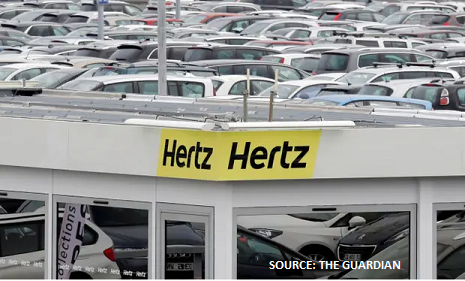Hertz Goes Bankrupt As Non-Essential Consumer Demand Disappears

The US Federal Reserve has now spent $7tn bailing out Wall Street. But it couldn’t save the 102-year old Hertz (HTZ) rental company from filing for Chapter 11 bankruptcy protection for its US business on Friday night.
Sadly, Hertz won’t be the only casualty. Its collapse instead marks the moment when the problems created by two decades of doomed central bank stimulus measures began to become obvious:
- All along, the central banks have confused liquidity with solvency
- They have provided $tns of liquidity – but they can’t create business models that deliver profit
- Instead. they have created a host of “zombie companies” – who make no money, but never die
And this isn’t just my view, but also the view of the central bankers’ bank, the Bank for International Settlements. It says the number of zombies has risen from just 2% of all companies in the 1980s to 10% of European firms and >15% of US companies due to:
“Their reliance on rolling over loans as their interest bill exceeds their Earnings Before Interest & Taxes.”
Hertz’s problems are also not new, as the New York Times notes:
“Hertz has also had a debt problem that can be traced back to a 2005 leveraged buyout by private-equity firms.”
2005, of course, was the peak of the subprime bubble – when the Fed abandoned its core role of ensuring financial stability, and instead began encouraging companies and individuals to take on more and more debt. I warned here and in the Financial Times at the time that this would end in tears, but the Fed naturally took no notice till the crisis was already well underway.
Today, as the Wall Street Journal has confirmed:
- “Hertz has $19bn of debt and nearly 700,000 vehicles that have been largely idled because of the coronavirus.
- It has spent years trying to restructure its business, and has blown through four chief executives in less than a decade.
- The company lost some $58m last year, its fourth consecutive annual net loss”
The issue is simple. When the central banks run their printing presses, they create liquidity. But they can’t print babies – and in the end, it’s only babies when they grow up and join the workforce that can create genuine demand.
No doubt, the central banks will again claim – as in 2008 – that “nobody could have seen this coming”. But we have been warning for some time in The pH Report that the US auto market was headed for a major downturn. And as we noted this month:
- “Hertz, Avis and Enterprise have cancelled all orders of GM vehicles for May, June and into July. Hertz said in a filing Tuesday that it doesn’t expect to acquire new vehicles for the remainder of this year.
- Hertz’s widely publicised financial problems suggest it may well need to sell off a large part of its fleet – currently sitting idle on airport parking lots – to raise cash
- This will add to the pressure on auto prices – both used and new – from the expected 4m used cars already due to come off-lease this year”
Rental sales are typically 20% of totally auto sales, so the collapse of rental demand is significant in itself. It will also hit the wider market for used cars. There are 285m vehicles in the US, and as Forbes notes:
“Beginning in March, nearly every passenger vehicle on the road lost value and will likely continue to lose value until a supply–demand equilibrium is established.”
Wall Street is currently ignoring these major second wave impacts, just as it shrugged off the fact that only GM reported a profit in Q1 (GM).
Instead it is assuming a strong V-shaped recovery is already underway. But if this assumption proves wrong, it will then face the reality that US automakers have become dependent on US sales for the majority of their global profits.
AUTO INDUSTRY TROUBLES WILL CREATE A VICIOUS CIRCLE
If these profits continue to evaporate, as looks likely, then the restructuring required will be greater than in 2008, with an enormous impact down supply and value chains.
Hertz employs 29k employees in the US, according to Reuters, and had already laid off 10k of them last month. In turn, this will cause further layoffs down the value chain. It will effectively create a vicious circle where those who lose their jobs have to cutback on their own spending due to loss of income – in turn, causing others to lose their jobs.
The auto industry is also the largest single customer for the chemical industry, worth $55bn last year, with each new car containing $3.25k of chemicals. Companies dependent on sales into the sector are also facing hard times as a result, with bankruptcies becoming more and more likely amongst those with the weakest balance sheets.
As I have warned here since early February, common sense tells us that we are entering a New Normal world, with no return possible to business as usual. Companies and investors who use their own common sense will be best placed to survive and prosper from the downturn ahead – whilst those who continue to believe in the power of central banks will risk sharing Hertz’s fate.
Disclosure: I wrote this article myself, and it expresses my own opinions. I am not receiving compensation for it. I have no business relationship with any company whose stock is mentioned in this ...
more



So no government bail-out for Hertz? They are not too big to fail?
Apparently not.